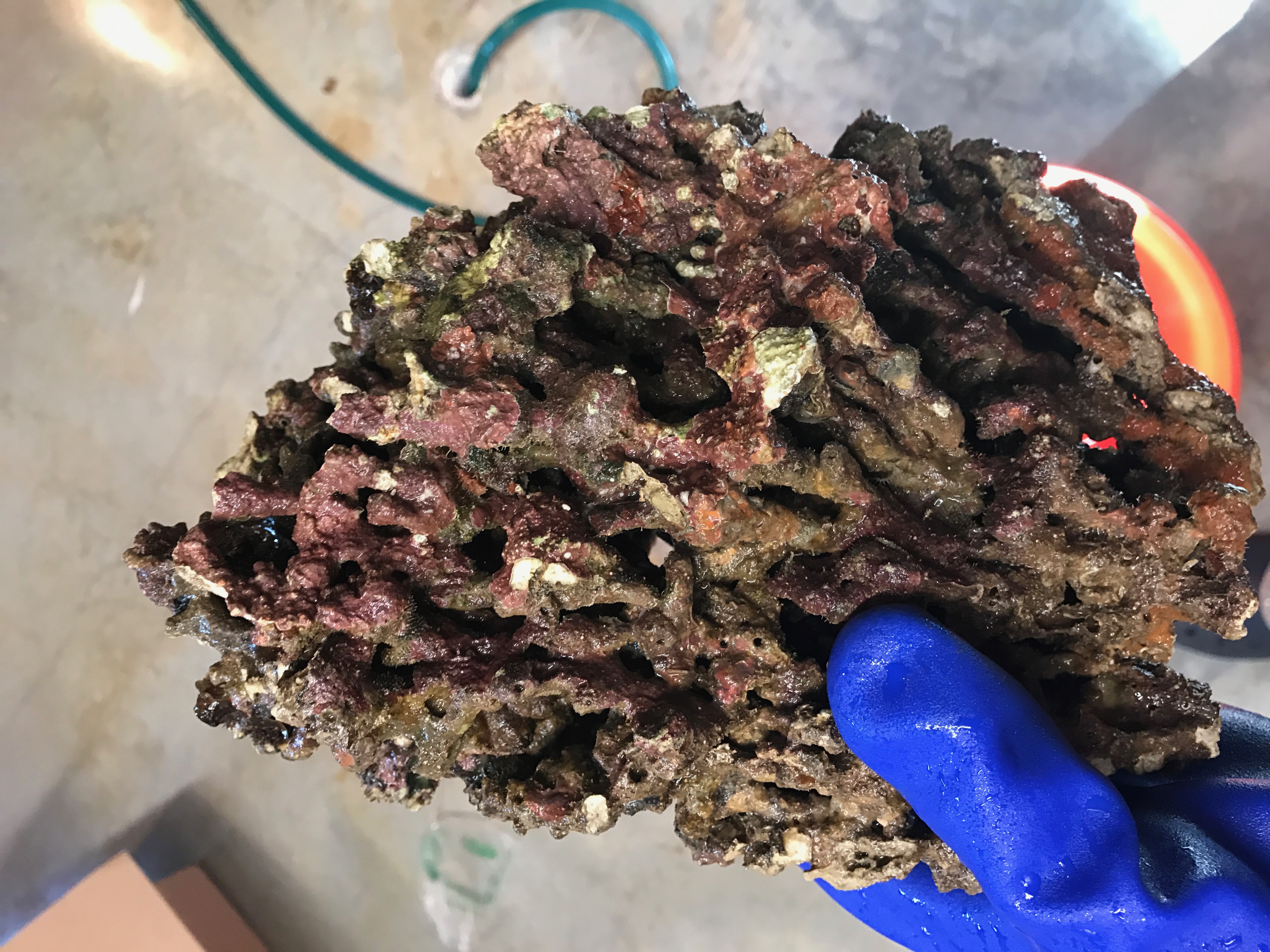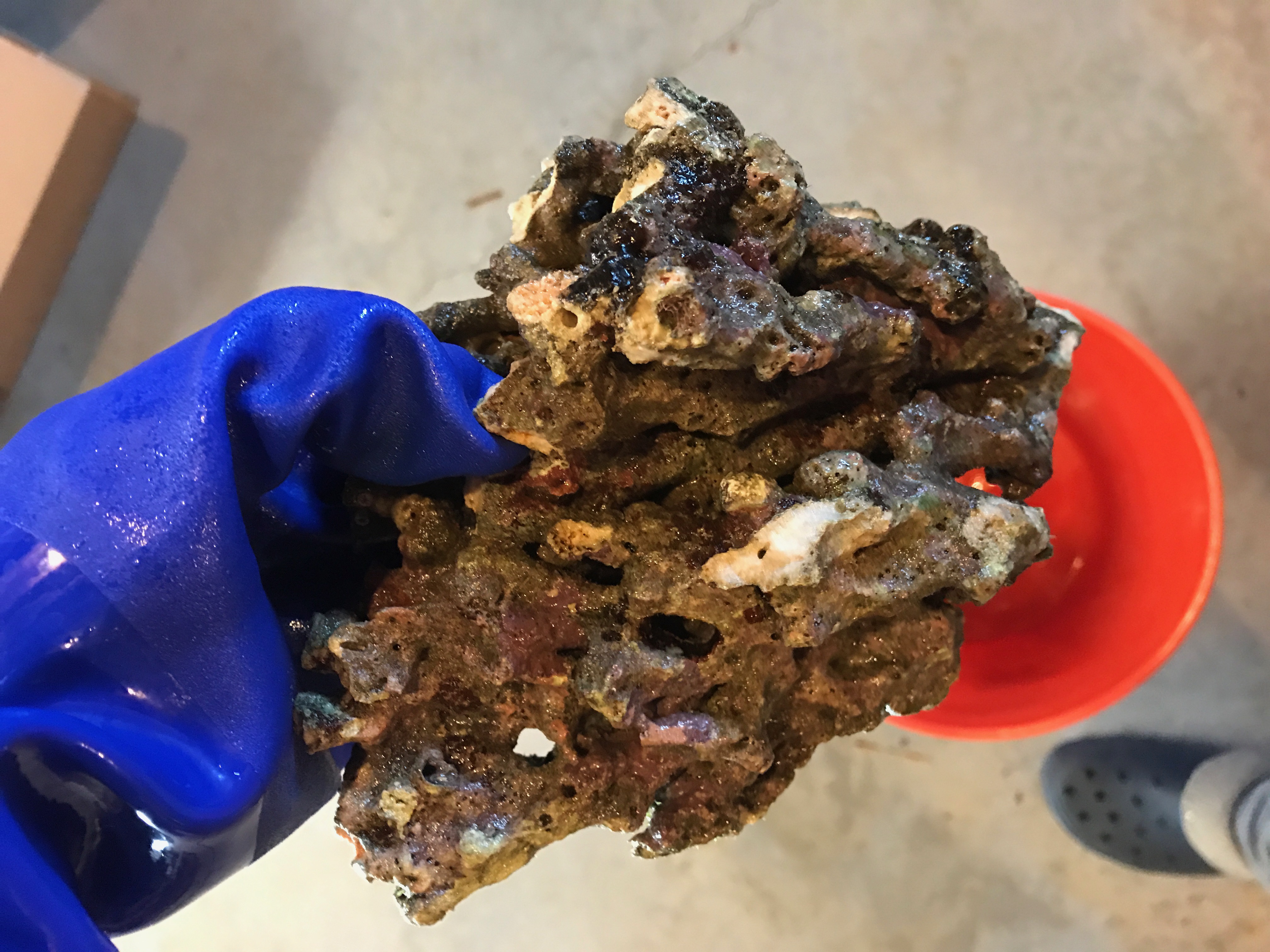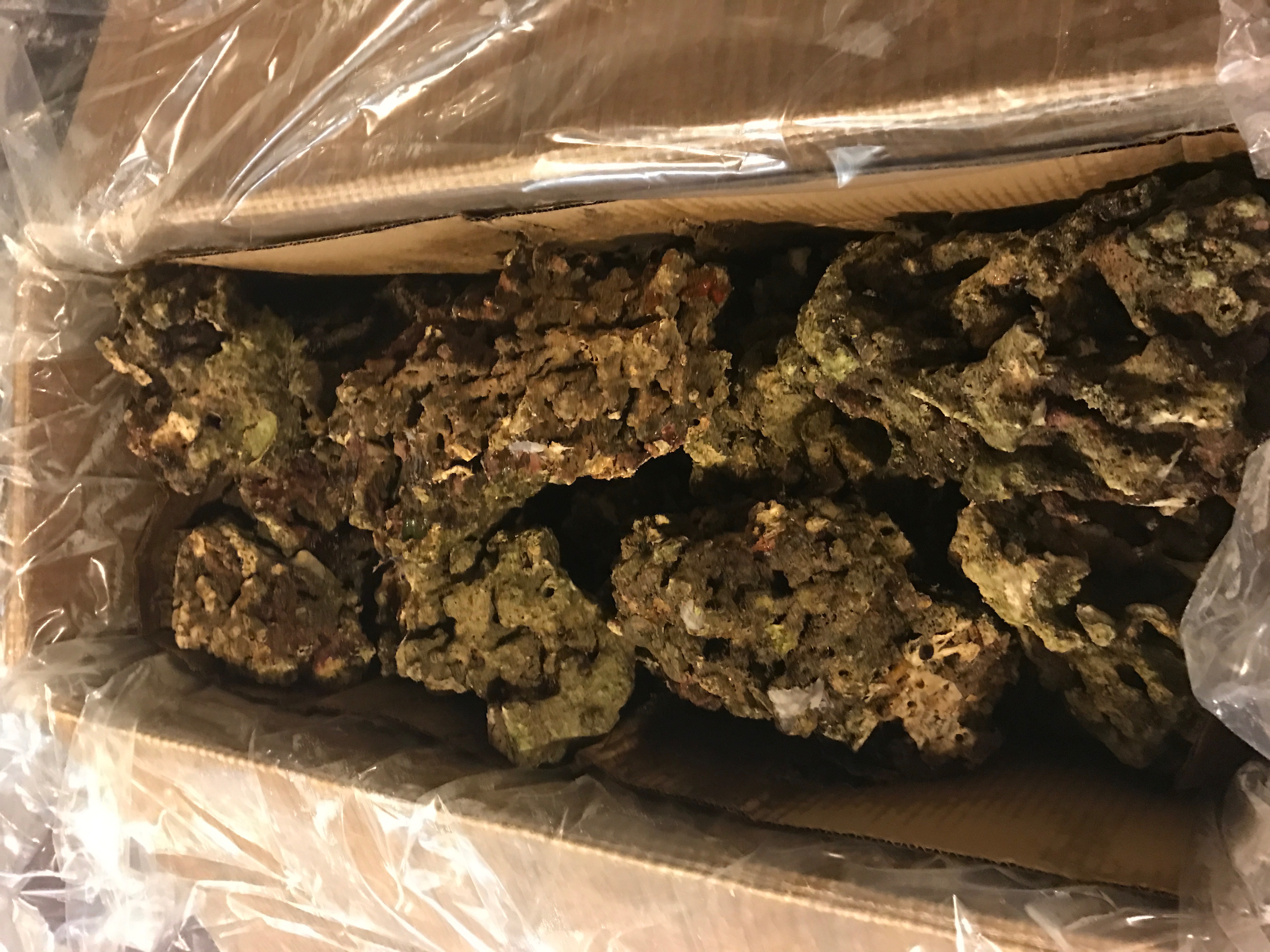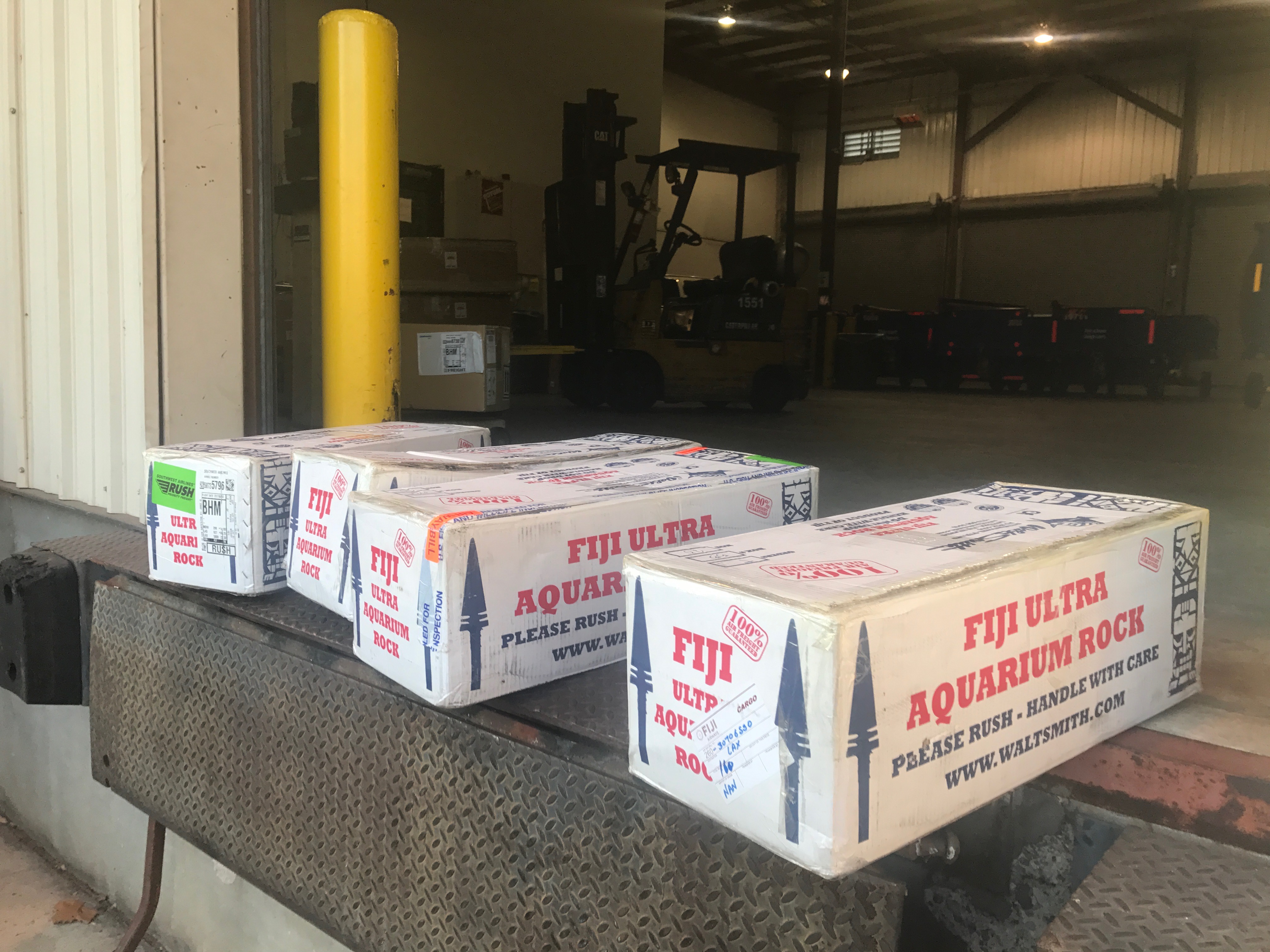- Joined
- Nov 14, 2018
- Messages
- 4
- Reaction score
- 908
Seawitch submitted a new Article:
Reef Aquarium Rock Explained, Part 1
Or, What Kind of Rock Can I Put in My Saltwater Tank?
In the broadest of terms, there are basically two types of rock for saltwater aquariums: live rock and dead rock. So, we're going to look at them one at a time, and try to explain the differences for the benefit of beginners.
Live rock from the ocean. There's bubble algae on it in the middle (a nuisance).

Photo is from the Reef2Reef archives, ©2018, All Rights Reserved
Live Rock:
Live rock is either A) wild rock that has either been plucked from the ocean or B) some other kind of rock, natural or artificial, that has been placed in the ocean (farmed) specifically for the purpose of making it live or C) some kind of natural or artificial rock that has been aquacultured on land with the appropriate organisms to make it "live". So, B) and C) above are the sustainable alternatives to wild-harvesting, and the only way to avoid damaging a living reef.
While live rock, for the most part, is a combination of dead pieces of coral, calcium carbonate, and other ocean material, it is also populated more or less with beneficial bacteria that serves as a chemical filter for saltwater aquarium water. This type of rock typically comes with other saltwater organisms attached both good ones and bad ones. What and how much arrives on or with your live rock depends on where it comes from and how well it has been shipped. If it has been in the ocean recently, it might have sponges, corals, tiny invertebrates, crabs, coralline algae, worms, feather dusters, and/or other forms of life.
Live rock is the foundation of both our ocean coral reefs and home reef aquariums.
Live artificial rock aquacultured in the ocean.

Photo is from the Reef2Reef archives, ©2018, All Rights Reserved
While live rock is not an aquarium requirement, reef aquarists generally choose to use at least some of it for the pleasing aesthetic it brings to a tank (live rocks are often vibrant purple, green, or red), on principle to create an environment for the inhabitants as close to the real one as is possible in a glass box, as well as the practical benefits of providing shelter and nitrification. Waste from old food, poop, or decaying organisms increases ammonia levels. Live rocks are typically already colonized with bacteria that help convert waste into less harmful compounds, and depending on the condition of the rock, more bacteria will develop inside it and on it over time. Live rock eventually becomes a major part the aquarium filter.
Most of the live rock you’ll find online or at a local fish store is harvested from a living coral reef. In some areas, live rock is harvested using dynamite or crowbars. Because this is such a destructive practice, many nations have banned this type of harvesting, although live rock can also be collected in shallow ocean water where small pieces of coral wash up after being detached from the reef due to storms or other damage, assuming it's legal in whatever area that is.
Live rock from the ocean can be reef rock, inshore reef rock, and reef rock from darker areas of a reef system that may have much less life on them. Depending on where the rock comes from, the life forms on it may be slightly different.
At the time of this writing, according to Mike Paletta, "the collection of ornamental fish in Hawaii is BANNED. The collection and sale of live rock and coral from Fiji: BANNED. The permits for shipping coral, anemones and live rock from Indonesia: HALTED."
Much of the available (wild) live rock comes from the Caribbean and the South Pacific and each type, typically named for the area it’s from, has its own unique qualities. Some live rock is dense, and some is very lightweight and porous. And artificial live rock may have an altogether different density or porosity. That's why the rule of thumb of 2 pounds of live rock per gallon of tank water is not a hard and fast rule. Furthermore, live rock is expensive.
Sites like Saltwater Aquarium Blog and ReefHacks suggest setting up your tank with dry or dead rock and adding in 10 to 20 pounds of live rock once you’re happy with how it looks. Dry rock is less expensive than live rock, doesn’t have any hitchhikers, and will, over time, become colonized by coralline algae, bacteria, and invertebrates from the live rock you add to your tank.
Live rock is chosen for its look so it’s best to purchase it in person at a local fish store. This isn’t always possible so here are a few online places to find live rock.
● Fishy Business Aquatics
● World Wide Corals
● LiveAquaria
● Amazon
Make sure to read the reviews, check that they ship to your country, and ask the helpful aquarists in the Reef2Reef forums for advice.
No matter where you get your live rock, if organisms on the live rock die off during harvesting and transportation (and they will) they pose a risk to your aquarium. These rocks require curing before installation in order to remove the dead and decaying material. Curing is a topic that we will explore in depth in a future article.
How to tell if your live rock needs curing:
● Smell the rock to see if it stinks of rotten fish. If so, it needs curing.
● Place the rock in a container of saltwater (that is the appropriate temperature and with a filter or powerhead to move the water around) for a day and then test for ammonia. If there’s ammonia, your rock needs curing.
Dry Rock Sometimes Referred to as Dry Live Rock
Dry live rock is not exactly alive but it's not exactly dead either, so I'm grouping it with live rock. Remember the movie, "The Princess Bride?" "It just so happens that your friend here is only MOSTLY dead. There's a big difference between mostly dead and all dead. Mostly dead is slightly alive."
Dry live rock is rock that used to be alive, but hasn't been alive for a while. So, either this rock has been out of water or it has been in a dead tank with no obvious signs of life. Now, if it's been sitting in the sun for 10 years, then it's probably completely dead, but if the rock has only been out of water for a few weeks or months, then it may still have some life in it, even if it's only spores waiting for the right conditions to come alive again.
If it stinks with a crash, then it has some decaying matter in it or on it. In any case, no matter how alive or how dead it is, it has to be cured. And curing dry live rock is slightly different than curing live rock.
Dry live rock may be slightly alive or totally dead, but its benefit over live rock is twofold: dry live rock is cheaper than live rock, and it's very unlikely to contain any bad hitchhikers.
Dry live rock also has a downside. If it contains hardly any or no life, then it might as well be dead, because it will take as long as dead rock to revive under the right conditions. It can be more difficult to cure, and it's highly unlikely to have any good hitchhikers either.
If you're not sure if your rock is alive or dead, find out where the source was. If the rock came from an inland quarry, it's dead no matter what it's called or branded. If it hasn't been alive in 1000 years, then it's dead. Similarly, if it was recently alive but has been sterilized, and is guaranteed not to have anything bad on it, then it is also not going to have anything good on it either. That's called dead rock.
In Part 2, we'll talk about dead rock. And by that we mean totally, thoroughly, and completely dead.
A very pretty small rock aquascape.

Photo from the Reef2Reef archives, Travis Stewart © 2018, All Rights Reserved
Additional resources:
● Buying Live Rocks for Your Marine Aquarium
● How Much Live Rock Do I Need?
● How to Cure Live Rock
● Live Rock (Wikipedia)
● https://www.practicalfishkeeping.co.uk/features/articles/how-to-make-your-own-live-rock
● http://www.tfhmagazine.com/saltwate.../creating-your-own-live-rock-full-article.htm
● https://www.reef2reef.com/threads/banned-but-is-there-still-hope.403782/
● https://www.law.cornell.edu/cfr/text/50/622.225
About the Author: Robyn Roste

With more than 10 years of experience in writing, marketing, and audio editing, Robyn Roste’s experience combines new media, broadcast media, journalism, public relations, and social media. She has a Bachelor of Journalism and loves learning new things and helping people understand complex subjects. Robyn recently won a prize from the Professional Writers Association of Canada (PWAC) and was shortlisted for a Literary Arts Award in British Columbia.
Now living in British Columbia, Canada’s beautiful Fraser Valley, Robyn enjoys rural living even if it means running into the occasional wild animal. When there’s spare time, Robyn and her husband travel to places where they can snorkel and see the fish from The Blue Planet for themselves.
Reef Aquarium Rock Explained, Part 1
Or, What Kind of Rock Can I Put in My Saltwater Tank?
In the broadest of terms, there are basically two types of rock for saltwater aquariums: live rock and dead rock. So, we're going to look at them one at a time, and try to explain the differences for the benefit of beginners.
Live rock from the ocean. There's bubble algae on it in the middle (a nuisance).
Photo is from the Reef2Reef archives, ©2018, All Rights Reserved
Live Rock:
Live rock is either A) wild rock that has either been plucked from the ocean or B) some other kind of rock, natural or artificial, that has been placed in the ocean (farmed) specifically for the purpose of making it live or C) some kind of natural or artificial rock that has been aquacultured on land with the appropriate organisms to make it "live". So, B) and C) above are the sustainable alternatives to wild-harvesting, and the only way to avoid damaging a living reef.
While live rock, for the most part, is a combination of dead pieces of coral, calcium carbonate, and other ocean material, it is also populated more or less with beneficial bacteria that serves as a chemical filter for saltwater aquarium water. This type of rock typically comes with other saltwater organisms attached both good ones and bad ones. What and how much arrives on or with your live rock depends on where it comes from and how well it has been shipped. If it has been in the ocean recently, it might have sponges, corals, tiny invertebrates, crabs, coralline algae, worms, feather dusters, and/or other forms of life.
Live rock is the foundation of both our ocean coral reefs and home reef aquariums.
Live artificial rock aquacultured in the ocean.
Photo is from the Reef2Reef archives, ©2018, All Rights Reserved
While live rock is not an aquarium requirement, reef aquarists generally choose to use at least some of it for the pleasing aesthetic it brings to a tank (live rocks are often vibrant purple, green, or red), on principle to create an environment for the inhabitants as close to the real one as is possible in a glass box, as well as the practical benefits of providing shelter and nitrification. Waste from old food, poop, or decaying organisms increases ammonia levels. Live rocks are typically already colonized with bacteria that help convert waste into less harmful compounds, and depending on the condition of the rock, more bacteria will develop inside it and on it over time. Live rock eventually becomes a major part the aquarium filter.
Most of the live rock you’ll find online or at a local fish store is harvested from a living coral reef. In some areas, live rock is harvested using dynamite or crowbars. Because this is such a destructive practice, many nations have banned this type of harvesting, although live rock can also be collected in shallow ocean water where small pieces of coral wash up after being detached from the reef due to storms or other damage, assuming it's legal in whatever area that is.
Live rock from the ocean can be reef rock, inshore reef rock, and reef rock from darker areas of a reef system that may have much less life on them. Depending on where the rock comes from, the life forms on it may be slightly different.
At the time of this writing, according to Mike Paletta, "the collection of ornamental fish in Hawaii is BANNED. The collection and sale of live rock and coral from Fiji: BANNED. The permits for shipping coral, anemones and live rock from Indonesia: HALTED."
Much of the available (wild) live rock comes from the Caribbean and the South Pacific and each type, typically named for the area it’s from, has its own unique qualities. Some live rock is dense, and some is very lightweight and porous. And artificial live rock may have an altogether different density or porosity. That's why the rule of thumb of 2 pounds of live rock per gallon of tank water is not a hard and fast rule. Furthermore, live rock is expensive.
Sites like Saltwater Aquarium Blog and ReefHacks suggest setting up your tank with dry or dead rock and adding in 10 to 20 pounds of live rock once you’re happy with how it looks. Dry rock is less expensive than live rock, doesn’t have any hitchhikers, and will, over time, become colonized by coralline algae, bacteria, and invertebrates from the live rock you add to your tank.
Live rock is chosen for its look so it’s best to purchase it in person at a local fish store. This isn’t always possible so here are a few online places to find live rock.
● Fishy Business Aquatics
● World Wide Corals
● LiveAquaria
● Amazon
Make sure to read the reviews, check that they ship to your country, and ask the helpful aquarists in the Reef2Reef forums for advice.
No matter where you get your live rock, if organisms on the live rock die off during harvesting and transportation (and they will) they pose a risk to your aquarium. These rocks require curing before installation in order to remove the dead and decaying material. Curing is a topic that we will explore in depth in a future article.
How to tell if your live rock needs curing:
● Smell the rock to see if it stinks of rotten fish. If so, it needs curing.
● Place the rock in a container of saltwater (that is the appropriate temperature and with a filter or powerhead to move the water around) for a day and then test for ammonia. If there’s ammonia, your rock needs curing.
Dry Rock Sometimes Referred to as Dry Live Rock
Dry live rock is not exactly alive but it's not exactly dead either, so I'm grouping it with live rock. Remember the movie, "The Princess Bride?" "It just so happens that your friend here is only MOSTLY dead. There's a big difference between mostly dead and all dead. Mostly dead is slightly alive."
Dry live rock is rock that used to be alive, but hasn't been alive for a while. So, either this rock has been out of water or it has been in a dead tank with no obvious signs of life. Now, if it's been sitting in the sun for 10 years, then it's probably completely dead, but if the rock has only been out of water for a few weeks or months, then it may still have some life in it, even if it's only spores waiting for the right conditions to come alive again.
If it stinks with a crash, then it has some decaying matter in it or on it. In any case, no matter how alive or how dead it is, it has to be cured. And curing dry live rock is slightly different than curing live rock.
Dry live rock may be slightly alive or totally dead, but its benefit over live rock is twofold: dry live rock is cheaper than live rock, and it's very unlikely to contain any bad hitchhikers.
Dry live rock also has a downside. If it contains hardly any or no life, then it might as well be dead, because it will take as long as dead rock to revive under the right conditions. It can be more difficult to cure, and it's highly unlikely to have any good hitchhikers either.
If you're not sure if your rock is alive or dead, find out where the source was. If the rock came from an inland quarry, it's dead no matter what it's called or branded. If it hasn't been alive in 1000 years, then it's dead. Similarly, if it was recently alive but has been sterilized, and is guaranteed not to have anything bad on it, then it is also not going to have anything good on it either. That's called dead rock.
In Part 2, we'll talk about dead rock. And by that we mean totally, thoroughly, and completely dead.
A very pretty small rock aquascape.
Photo from the Reef2Reef archives, Travis Stewart © 2018, All Rights Reserved
Additional resources:
● Buying Live Rocks for Your Marine Aquarium
● How Much Live Rock Do I Need?
● How to Cure Live Rock
● Live Rock (Wikipedia)
● https://www.practicalfishkeeping.co.uk/features/articles/how-to-make-your-own-live-rock
● http://www.tfhmagazine.com/saltwate.../creating-your-own-live-rock-full-article.htm
● https://www.reef2reef.com/threads/banned-but-is-there-still-hope.403782/
● https://www.law.cornell.edu/cfr/text/50/622.225
About the Author: Robyn Roste
With more than 10 years of experience in writing, marketing, and audio editing, Robyn Roste’s experience combines new media, broadcast media, journalism, public relations, and social media. She has a Bachelor of Journalism and loves learning new things and helping people understand complex subjects. Robyn recently won a prize from the Professional Writers Association of Canada (PWAC) and was shortlisted for a Literary Arts Award in British Columbia.
Now living in British Columbia, Canada’s beautiful Fraser Valley, Robyn enjoys rural living even if it means running into the occasional wild animal. When there’s spare time, Robyn and her husband travel to places where they can snorkel and see the fish from The Blue Planet for themselves.





 image
image image
image image
image image
image









